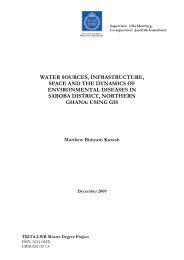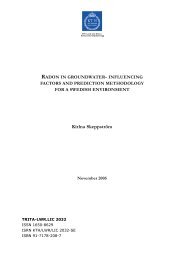Comparison between 1D and 2D models to analyze the dam break
Comparison between 1D and 2D models to analyze the dam break
Comparison between 1D and 2D models to analyze the dam break
- No tags were found...
You also want an ePaper? Increase the reach of your titles
YUMPU automatically turns print PDFs into web optimized ePapers that Google loves.
<strong>Comparison</strong> <strong>between</strong> <strong>1D</strong> <strong>and</strong> <strong>2D</strong> <strong>models</strong> <strong>to</strong> <strong>analyze</strong> <strong>the</strong> <strong>dam</strong> <strong>break</strong> wave - Appendix- formulation of <strong>the</strong> objective of <strong>the</strong> risk analysisbased on <strong>the</strong> main concerns identified,- identification of <strong>the</strong> decisions <strong>to</strong> be made, <strong>the</strong>decision-making criteria <strong>and</strong> <strong>the</strong> decision-makers,- description of <strong>the</strong> proposed risk analysis processincluding statement of <strong>the</strong> assumptions <strong>and</strong>constraints governing <strong>the</strong> analysis.Risk analysis for <strong>dam</strong> systems can be categorized by<strong>the</strong> nature of <strong>the</strong> hazards leading <strong>to</strong> <strong>the</strong> consequencesof concern. The hazards in question may be groupedin<strong>to</strong> four general categories, namely:- hazards due <strong>to</strong> natural conditions (normal loads,earthquakes, floods, debris, winds, etc.);- operational hazards (spillway reliability, opera<strong>to</strong>rerror, etc.);- internal hazards (aging, alkali-aggregate reaction,internal erosion, metal fatigue, etc.); <strong>and</strong>- social hazards (war, sabotage, etc.).Failures are often categorized as static, hydrologic orseismic. Some of <strong>the</strong> various fac<strong>to</strong>rs, are presented in<strong>the</strong> figure below:Figure 57. Some fac<strong>to</strong>rs <strong>to</strong> cause <strong>dam</strong> failures.Risk estimation entails <strong>the</strong> assignment of probabilities<strong>to</strong> <strong>the</strong> events <strong>and</strong> responses identified under riskidentification. The assessment of appropriateprobability estimates is one of <strong>the</strong> most difficult tasksof <strong>the</strong> entire process. The outcome of this step is acalculation of <strong>the</strong> risk of failure.Risk evaluation.Risk evaluation is <strong>the</strong> process of examining <strong>and</strong>judging <strong>the</strong> significance of risk. The risk evaluationstage is <strong>the</strong> point at which values (societal, regula<strong>to</strong>ry,legal <strong>and</strong> owners) <strong>and</strong> judgements enter <strong>the</strong> decisionprocess, explicitly or implicitly, by includingconsideration of <strong>the</strong> importance of <strong>the</strong> estimated risks<strong>and</strong> <strong>the</strong> associated social, environmental, <strong>and</strong>economic consequences, in order <strong>to</strong> identify a range ofalternatives for managing <strong>the</strong> risks.Risk mitigation is a selective application of appropriatetechniques <strong>and</strong> management principles <strong>to</strong> reduceei<strong>the</strong>r likelihood of an occurrence or its consequences,or both (ICOLD, 1999).Risk acceptance is an informed decision <strong>to</strong> accept <strong>the</strong>likelihood <strong>and</strong> <strong>the</strong> consequences of a particular risk(ICOLD, 1999). Risk acceptance is coupled <strong>to</strong> <strong>the</strong> riskreduction evaluation <strong>and</strong> is a basis for deciding whatresidual risk will be accepted for <strong>the</strong> affectedcommunity <strong>and</strong> structures.Risk managementRisk management is <strong>the</strong> systematic application ofmanagement policies, procedures <strong>and</strong> practices <strong>to</strong> <strong>the</strong>task of identifying, analyzing, assessing, treating <strong>and</strong>moni<strong>to</strong>ring risk (ICOLD, 1999). Having received <strong>the</strong>risk information, <strong>and</strong> knowing <strong>the</strong> risk valuationcriteria, a decision-maker must come <strong>to</strong> a decision. Anumber of good practice steps <strong>to</strong> be taken <strong>to</strong> aid <strong>the</strong>decision process are given by <strong>the</strong> ICOLD. These stepsshould include e.g. consultations with stakeholders <strong>and</strong>community, insurance issues, legal defensibility ofdecisions, risk information <strong>to</strong> decision-maker, <strong>and</strong> <strong>to</strong><strong>the</strong> public, clarification of <strong>the</strong> role of decision-maker<strong>and</strong> documentation of <strong>the</strong> decision <strong>and</strong> its rationalimposes a discipline that is helpful <strong>to</strong> sound decisionmaking.Causes <strong>and</strong> probabilities of <strong>dam</strong> incidentsThe data, which have become available in <strong>the</strong> last 10 -20 years, provide a foundation for <strong>the</strong> ideasrecommended <strong>to</strong> be used in risk analysis. This studyaddresses risks associated with <strong>the</strong> construction,operation, <strong>and</strong> failure of <strong>dam</strong>s, excluding indirectenvironmental or resettlement problems. The purposeof <strong>the</strong> study is <strong>to</strong> identify <strong>the</strong> main real risks associatedwith each type <strong>and</strong> height of <strong>dam</strong>, for allcircumstances. It may be of help in several respects:- in extensive risk analysis of very large <strong>dam</strong>s, <strong>to</strong>substantiate reliably <strong>the</strong> probabilities chosen in eventtrees;- in simplified risk analysis of smaller <strong>dam</strong>s, <strong>to</strong> focuslow-cost risk analysis on a few main risks;- in identifying possibilities for reducing <strong>the</strong>se risksthrough low-cost structural or non-structuralmeasures.When studying <strong>the</strong> possibilities of risk assessment <strong>the</strong>reported failure circumstances can be classified asfollows:• Exceptional circumstances: floods, upstream<strong>dam</strong>-<strong>break</strong> wave, earthquakes, <strong>and</strong> war. Riskassessment for exceptional circumstances islogically based on <strong>the</strong> probability <strong>and</strong> impac<strong>to</strong>f such circumstances.• Normal circumstances: first filling, aging(after two years operation) <strong>and</strong> internalerosion, <strong>and</strong> construction. For <strong>dam</strong>s innormal circumstances <strong>the</strong> safety is essentiallybased on human behaviour, <strong>and</strong> riskassessment should pay a great deal ofattention <strong>to</strong> this point.B) DAM BREAK HAZARD ANALYSISIntroductionDam <strong>break</strong> modelling consist of first, prediction of <strong>the</strong>outflow hydrograph due <strong>to</strong> <strong>dam</strong> breach <strong>and</strong> latter,routing <strong>the</strong> hydrograph through <strong>the</strong> downstream valley25
















